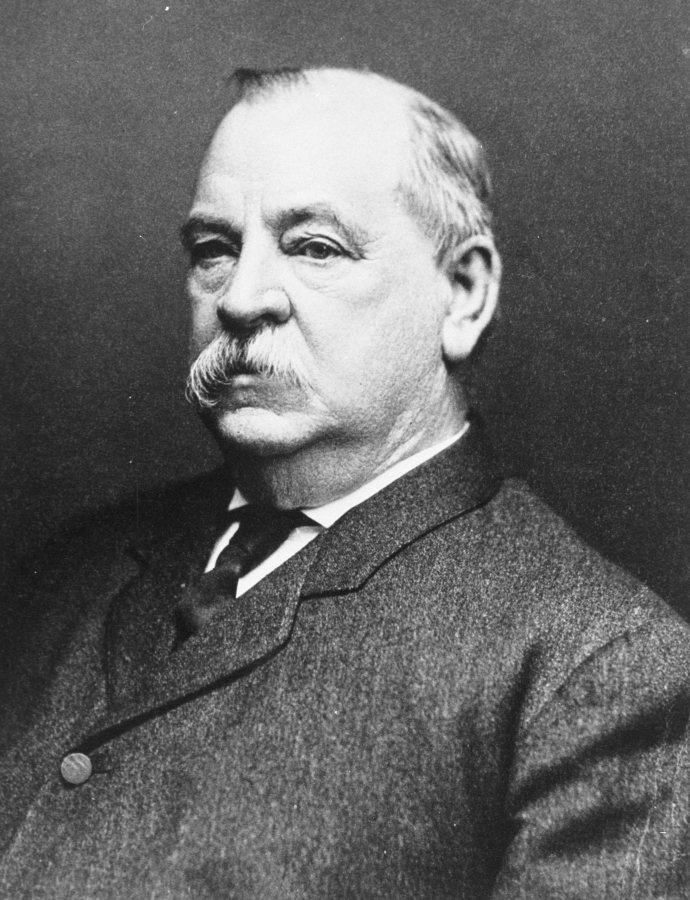With Thanksgiving just around the corner, everyone has food and great feasts on the brain.
On Saturday July 25, 1891, Grover Cleveland sat down to a banquet in his honor in the town of Sandwich, Mass., the oldest town on Cape Cod.
The purpose of the banquet has perhaps been lost to the mists of history, unless someone is willing to spend more than the 20 minutes I just wasted trying to look it up.
Cleveland had left office as the 22nd president of the United States two years before the banquet. He had lost reelection to Benjamin Harrison in 1888, though he won the popular vote, and had been nominated one month before the banquet to run again for the office by the Democratic Party. He would win that election the next year (his running mate, incidentally, was Adlai Stevenson, grandfather of the Adlai Stevenson who unsuccessfully ran for president twice in the 1950s).
The banquet appears to have been a grand affair. An etching of the event that ran in Harper’s Weekly two weeks later shows a large banquet hall filled with citizens in their best finery. Cleveland, who had a summer house on nearby Buzzards Bay, stands at the center of the dais, before an impressive array of flag-inspired bunting.
Visible on the table in the foreground is a tray of meat, a platter of what could be vegetables and a dish of small delicacies.
It is the food that interests me the most.
As it happens, there is an extant menu from this banquet, in the digital collections of the New York Public Library. So now we know what a formal banquet was like at the height of the Gilded Age.
Spoiler alert: There was a lot of food, or at least a lot of courses. The diners presumably had a choice for each course, and their appropriate accompaniments. The gathered elite would have been pleased, but the staff in the kitchen must have been going out of their minds.
The bill of fare begins with a fish course, a single offering of boiled salmon served with fresh peas along with boiled potatoes, sliced tomatoes and sliced cucumbers.
I’m going to go out on a limb here and suggest that what they called “boiled” fish in 1891 is what we would call “poached” fish now — that is, the fish was gently simmered in water flavored with an assortment of aromatics such as onions, bay leaves and slices of lemon.
Otherwise, it would not be the sort of thing one would want to serve to the once and future president.
The next course was a selection of roasts. Diners could choose between a sirloin of beef with a dish gravy, spring lamb served with a mint sauce or turkey served with a cranberry sauce.
Dish gravy is the just the jus, the liquid that seeps out of the roast while it is cooking. And you can be certain the cranberry sauce did not have ridges on it from when they opened the can and plopped it unceremoniously onto a plate — though that is theoretically possible. Food has been canned in the United States since the early 1800s.
The next course on the bill of fare is vegetables, which I hope were served with the roasts. Here the choices were green corn — that’s corn that is young and tender — string beans, mashed potatoes or dressed lettuce. I think we can all agree that dressed lettuce is salad, right?
Only at this point did the meal make its way to the actual entrées, and here there were only two choices: filet of beef with a mushroom sauce or a lobster salad.
It’s Cape Cod. Lobsters were everywhere. I imagine the beef was the exotic choice.
Though no one could possibly have been hungry at this point, dessert was served next. Here, the choices included vanilla, strawberry, chocolate or pineapple ice cream.
Pineapple was special at the time; it did not become widely available in the continental United States until James D. Dole began producing it commercially in 1899, eight years after this banquet.
Everyone wanted to try it, but still: pineapple ice cream?
Also available for dessert were lemon and raspberry sherbets, assorted cakes and frozen pudding.
After dessert, of course, came fruit — bananas, pineapples (for the people wise enough not to get the pineapple ice cream), oranges and “water melon.”
After fruit, came coffee.
Cleveland died in Princeton, N.J., in 1908. He was 71 years old. I have no idea how he lasted that long.



